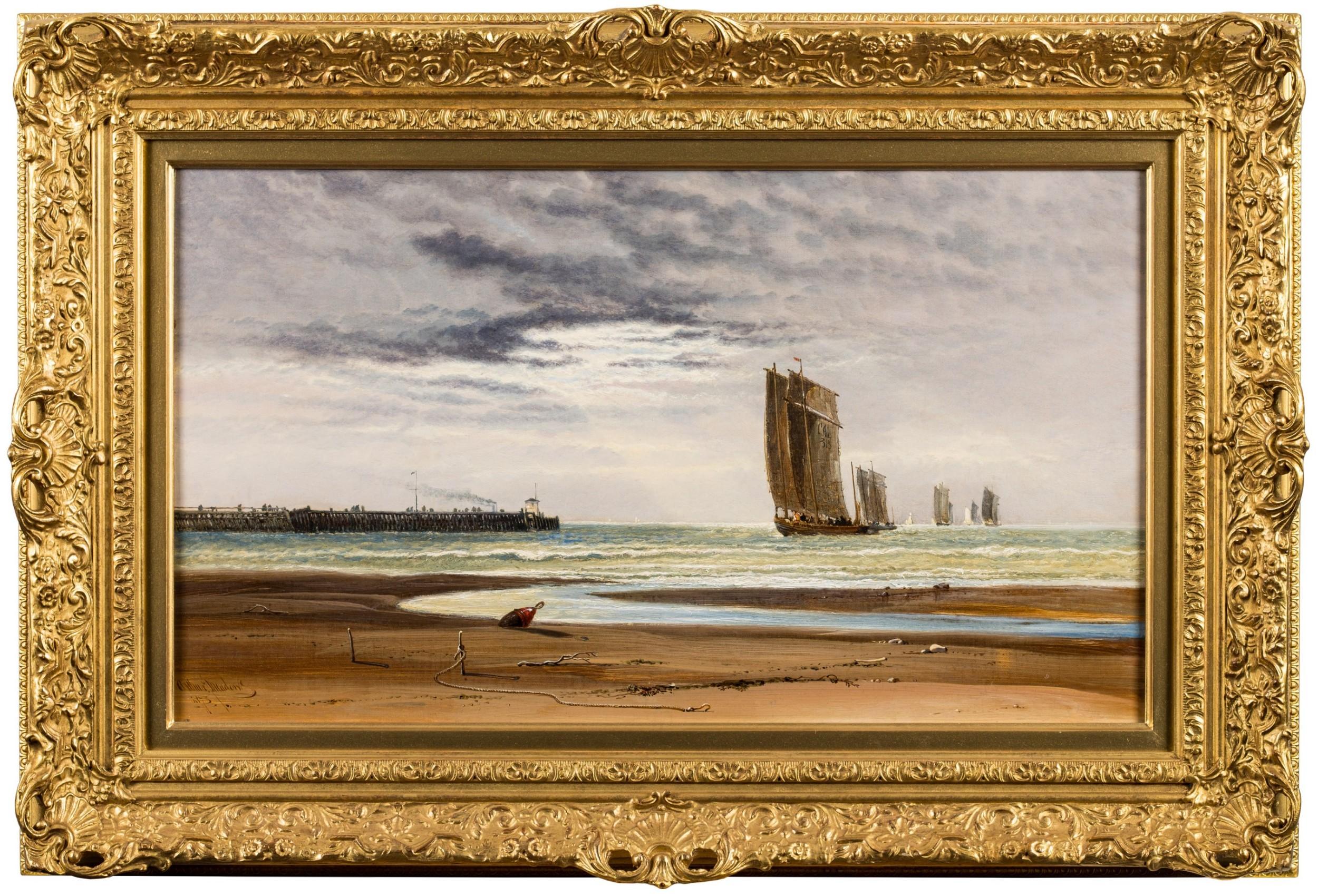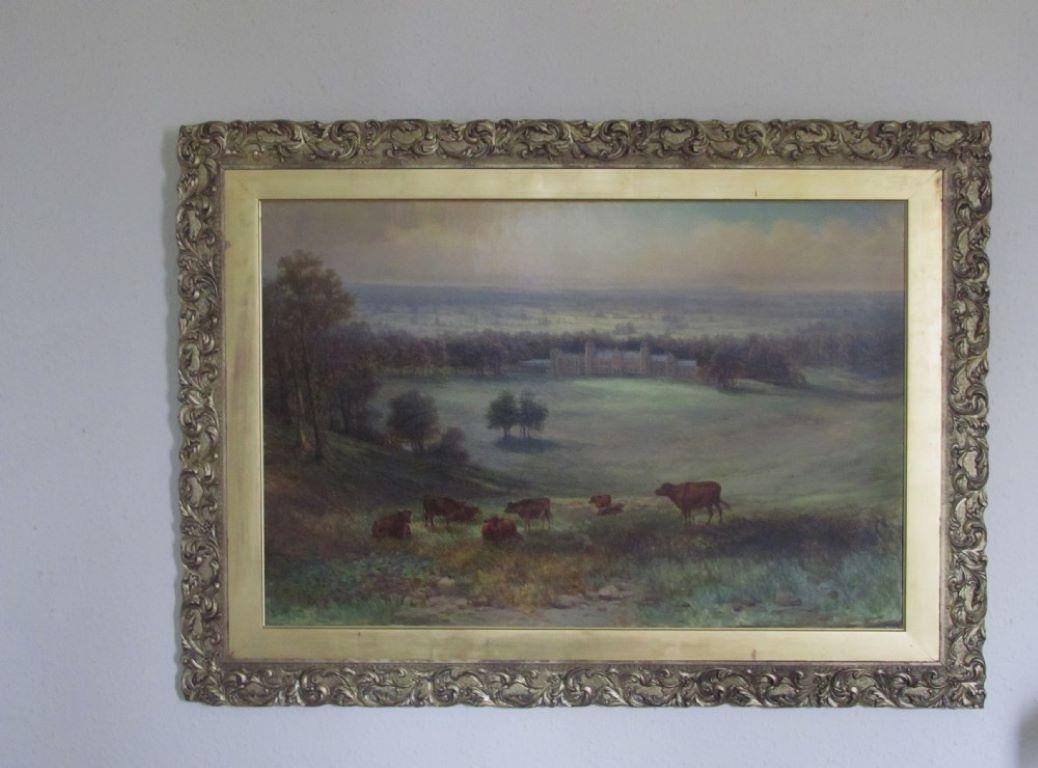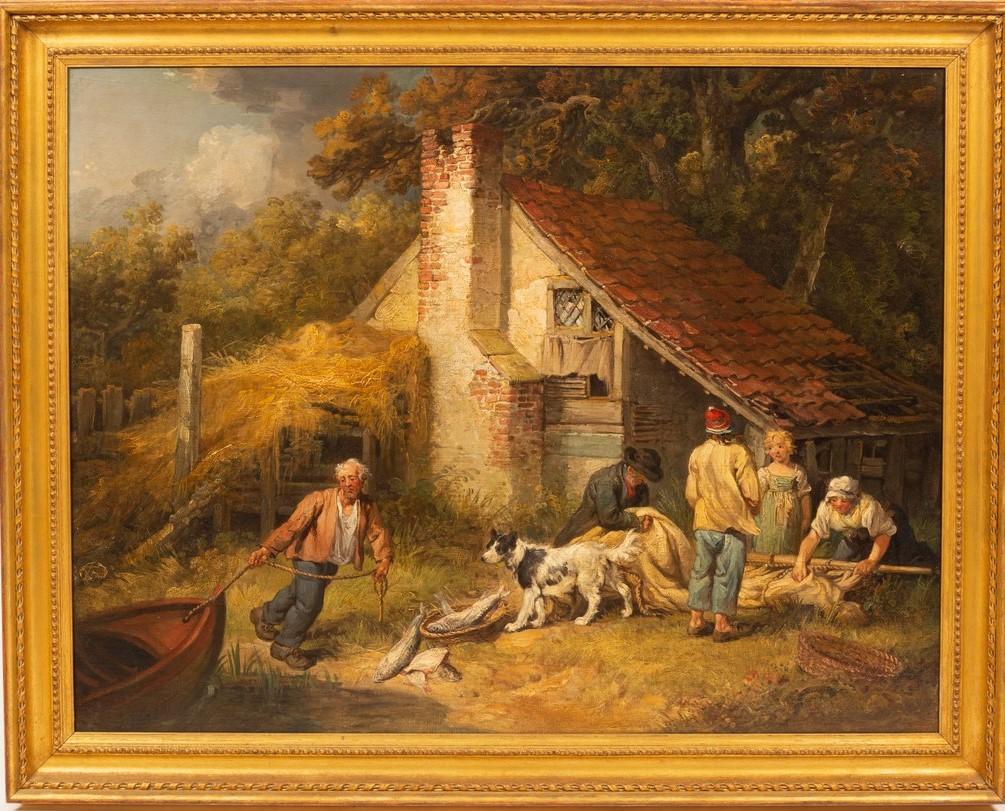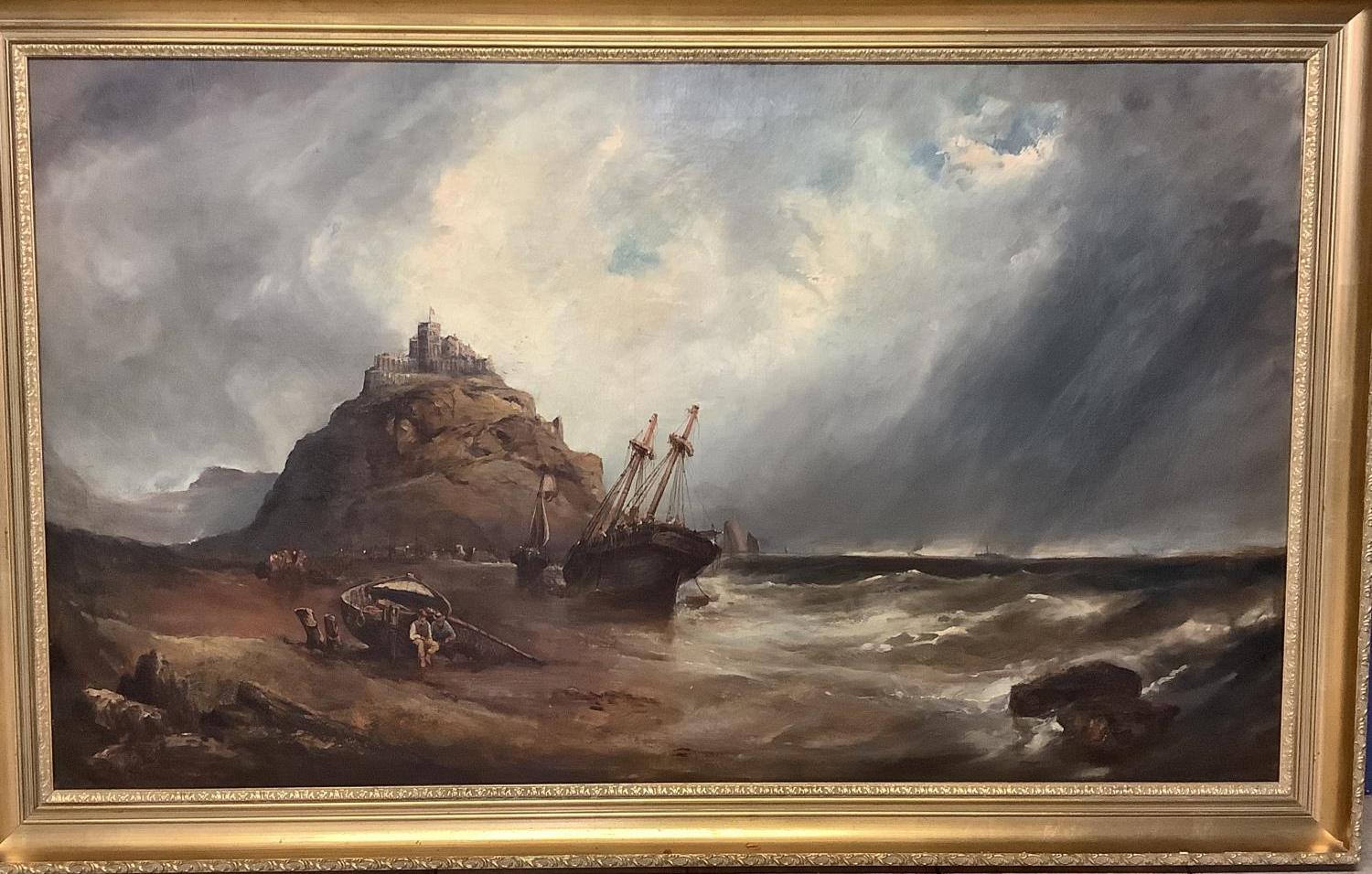Items Similar to After Hendrick MOMMERS (1623-1693) Haarlem Vegetable Market c1750
Want more images or videos?
Request additional images or videos from the seller
1 of 13
After Hendrick MOMMERS (1623-1693) Haarlem Vegetable Market c17501750
1750
About the Item
After Hendrick MOMMERS (1623-1693) Haarlem Vegetable Market c1750
An early copy c1750, of an entertaining Dutch vegetable market scene in an Italianate landscape. The original was painted by Hendrick Mommers, a renowned Dutch Golden Age landscape painter. Painted in oil onto an oak panel and presented in a later frame
Biography
According to Houbraken, Mommers was a Haarlem painter of vegetable market scenes, who was the first teacher of the young painter Dirk Maas
Mommers became a member of the Haarlem Guild of Saint Luke in 1647, where he was last registered in 1665 when he appears to have moved to Amsterdam.
Condition
In common with many paintings on early oak panels, it has split at some stage and then been repaired. The frame has minor repairs is 19th century and has been adapted to fit.
Size
47cm x 60cm (65cm x73cm framed)
18.5 x 23.6 inches (25.6 x 28.7 inches framed)
- Creation Year:1750
- Dimensions:Height: 18.5 in (46.99 cm)Width: 23.6 in (59.95 cm)
- Medium:
- Movement & Style:
- After:Hendrick Mommers (1623 - 1693, Dutch)
- Period:1750-1759
- Condition:
- Gallery Location:Holywell, GB
- Reference Number:
About the Seller
5.0
Vetted Seller
These experienced sellers undergo a comprehensive evaluation by our team of in-house experts.
Established in 1989
1stDibs seller since 2023
18 sales on 1stDibs
Typical response time: <1 hour
- ShippingRetrieving quote...Ships From: Holywell, United Kingdom
- Return PolicyA return for this item may be initiated within 14 days of delivery.
More From This SellerView All
- Follower of Wouwerman Dutch School c1800 Oil PaintingLocated in Holywell, GBFollower of Wouwerman Dutch School c1800 A delightful landscape painted on an oak panel, unsigned and dating from around 1800. The artist has deftly set the mood by placing his trav...Category
Early 1800s Old Masters Landscape Paintings
MaterialsOil
- Skagen Colony Danish School Oil PaintingLocated in Holywell, GBDanish School An idyllic scene of children in the sand dunes preparing to go fishing whilst a variety of vessels ply their trade off shore. Late 19th century and signed with the arti...Category
1890s Impressionist Landscape Paintings
MaterialsOil
- Fernand Laval (1886-1966) Paris School Art Deco Period Oil PaintingBy Fernand LavalLocated in Holywell, GBFernand Laval (1886-1966) Paris School Art Deco Period La fete des Loges 1929 A delightful post impressionist painting of a fairground scene in Loges, n...Category
Early 20th Century Post-Impressionist Landscape Paintings
MaterialsOil
- Louis Aston KNIGHT Stream in a Landscape Franco American ArtistBy Louis Aston KnightLocated in Holywell, GBLouis Aston KNIGHT (1873-1948) A languid stream in a verdant green landscape by the well recorded Franco American artist Louis Aston Knight. *Louis A...Category
Early 20th Century Impressionist Landscape Paintings
MaterialsOil
- Sovereign and Kurrewa America’s Cup Interest Oil PaintingBy Claude MuncasterLocated in Holywell, GBClaude MUNCASTER (1903-1974) Sovereign and Kurrewa America’s Cup Interest Oil Painting A sparkling depiction of the yachts Sovereign and Kurrewa in the 12 meter trial to determine t...Category
Mid-20th Century Impressionist Landscape Paintings
MaterialsOil
- Pierre Emmanuel Damoye (1847–1916) French Barbizon School Oil PaintingBy Pierre Emmanuel DamoyeLocated in Holywell, GBPierre Emmanuel Damoye (1847–1916) French Barbizon School A desolate snow covered landscape of fishing boats and nets drying on the banks of the river ...Category
Late 19th Century Impressionist Landscape Paintings
MaterialsOil
You May Also Like
- Early oil depicting the Great Fire of LondonLocated in London, GBThe Great Fire of London in September 1666 was one of the greatest disasters in the city’s history. The City, with its wooden houses crowded together in narrow streets, was a natural fire risk, and predictions that London would burn down became a shocking reality. The fire began in a bakery in Pudding Lane, an area near the Thames teeming with warehouses and shops full of flammable materials, such as timber, oil, coal, pitch and turpentine. Inevitably the fire spread rapidly from this area into the City. Our painting depicts the impact of the fire on those who were caught in it and creates a very dramatic impression of what the fire was like. Closer inspection reveals a scene of chaos and panic with people running out of the gates. It shows Cripplegate in the north of the City, with St Giles without Cripplegate to its left, in flames (on the site of the present day Barbican). The painting probably represents the fire on the night of Tuesday 4 September, when four-fifths of the City was burning at once, including St Paul's Cathedral. Old St Paul’s can be seen to the right of the canvas, the medieval church with its thick stone walls, was considered a place of safety, but the building was covered in wooden scaffolding as it was in the midst of being restored by the then little known architect, Christopher Wren and caught fire. Our painting seems to depict a specific moment on the Tuesday night when the lead on St Paul’s caught fire and, as the diarist John Evelyn described: ‘the stones of Paul’s flew like grenades, the melting lead running down the streets in a stream and the very pavements glowing with the firey redness, so as no horse, nor man, was able to tread on them.’ Although the loss of life was minimal, some accounts record only sixteen perished, the magnitude of the property loss was shocking – some four hundred and thirty acres, about eighty per cent of the City proper was destroyed, including over thirteen thousand houses, eighty-nine churches, and fifty-two Guild Halls. Thousands were homeless and financially ruined. The Great Fire, and the subsequent fire of 1676, which destroyed over six hundred houses south of the Thames, changed the appearance of London forever. The one constructive outcome of the Great Fire was that the plague, which had devastated the population of London since 1665, diminished greatly, due to the mass death of the plague-carrying rats in the blaze. The fire was widely reported in eyewitness accounts, newspapers, letters and diaries. Samuel Pepys recorded climbing the steeple of Barking Church from which he viewed the destroyed City: ‘the saddest sight of desolation that I ever saw.’ There was an official enquiry into the causes of the fire, petitions to the King and Lord Mayor to rebuild, new legislation and building Acts. Naturally, the fire became a dramatic and extremely popular subject for painters and engravers. A group of works relatively closely related to the present picture have been traditionally ascribed to Jan Griffier...Category
17th Century Old Masters Landscape Paintings
MaterialsOil, Canvas
- Stag Hunting in the Vicinity of Nuremberg by a German Artist Peter von BemmelLocated in PARIS, FRThis small landscape shows a hunting scene: two riders are chasing a stag with their dogs at the edge of a forest. Signed by Peter von Bemmel, it is typical of the production of this...Category
1720s Old Masters Landscape Paintings
MaterialsCopper
- Arthur Joseph Meadows 19th Century Seascape Off CalaisBy Arthur Joseph MeadowsLocated in York, GBA very fine painting by the renowned seascape painter Arthur Joseph Meadows,Off Calais; fishing fleet returning at low tide. Housed in an antique style gilt frame the size overall is...Category
19th Century Old Masters Landscape Paintings
MaterialsOil
- 19th Century, Victorian, landscape , cows , Country House Samuel Lawson BoothLocated in York, GBS Lawson Booth : Country House in extensive landscape with cattle in the foreground, oil on canvas signed and dated '98, 60cm x 90cm (35x23 inches approx image) size with frame appro...Category
19th Century Old Masters Landscape Paintings
MaterialsOil
- James ward landscape oil Bringing in the CatchBy James WardLocated in York, GBJames ward landscape oil Bringing in the Catch A charming scene of a family "bringing in the catch" showing figures outside a cottage, man pullng in the boat with his dog watching by...Category
19th Century Old Masters Landscape Paintings
MaterialsOil
- St Michael's Mount, Cornwall Seascape OilLocated in York, GBThis early 20th century oil on canvas depicts a nautical scene with a view of St Michaels Mount beyond. Although as yet, not attributed to a particular artist,this painting has cl...Category
Early 20th Century Old Masters Landscape Paintings
MaterialsOil





